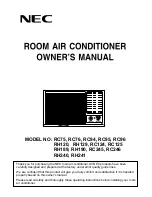
YORK INTERNATIONAL
36
FORM 100.50-NOM1 (604)
Startup
SECTION 3 – START-UP
To protect warranty, this equip ment
must be in stalled and ser viced by an
authorized YORK ser vice me chan ic or
a qualifi ed service per son ex pe ri enced
in air han dling and con dens er unit
in stal la tion. Installation must com ply
with all ap pli ca ble codes, par tic u lar ly
in regard to elec tri cal wiring and oth er
safety elements such as re lief valves,
HP cut-out settings, design work ing
pres sures and ven ti la tion re quire -
ments con sis tent with the amount
and type of re frig er ant charge.
Lethal voltages exist within the Con-
trol Panel. Before servicing, open and
tag all disconnect switches.
Reference publication Form 100.50-
N01 (302) "Quick Startup Guide" for
additional information.
CRANKCASE HEATERS
With power applied to the rooftop unit, the crank case
heater for each com pres sor will be ON when ev er the
com pres sor is not running. The heater is in ter locked into
the compressor motor contactor and is not con trolled
by the mi cro pro ces sor.
The purpose of the crankcase heater is to pre vent the
migration of refrigerant to the crank case during shut-
down, assuring proper lu bri ca tion of the com pres sor
on start-up.
Anytime power is removed from the unit for more than
an hour, the crankcase heater should be left on for 24
hours prior to start.
Power must be applied to the rooftop
unit 24 hours prior to starting the unit
com pres sors. Failure to observe this
re quire ment can lead to com pres sor
dam age and void ing of the com pres sor
war ran ty.
CHECKING THE SYS TEM
PRIOR TO INI TIAL START (NO POWER)
Unit Checks
1. Inspect the unit for shipping or installation dam-
age.
2. Visually check for refrigerant piping leaks.
3. The compressor oil level should be main tained so
that an oil level is visible in the sight glass. The oil
level can only be tested when the com pres sor is
run ning in stabilized conditions, guar an tee ing that
there is no liquid refrigerant in the lower shell of the
com pres sor. In this case, the oil must be between 1/4
and 3/4 in the sight glass. At shutdown, the oil level
can fall to the bottom limit of the oil sight glass.
4. Check the control panel to assure it is free of for eign
material (wires, metal chips, etc.).
5. Visually inspect
Þ
eld wiring (power and control).
Wir ing MUST meet N.E.C. and local codes.
6. Check tightness of terminal lugs inside the pow er
pan el on both sides of the contactors, over loads,
fus es, and pow er con nec tions.
7. Verify fuse sizing in main cir cuits.
8. Verify
Þ
eld wiring for ther mo stat (if ap pli ca ble),
op tion al zone sen sor, and optional CO
2
sen sor.
9. Verify all applicable pneumatic tubing has been
Þ
eld in stalled for duct static pressure transducers
(VAV units), op tion al building pressure transducer
for power exhaust option, and outdoor static pres-
sure prove.
10. Supply fan isolators spring bolts removed (refer to
Fig ure 13).
11. Verify proper bearing and locking collar torque
val ues on supply and exhaust fans (refer to Main-
te nance section of manual).
12. Verify proper drive alignment of supply and ex haust
fans (refer to Maintenance section of man u al).
















































